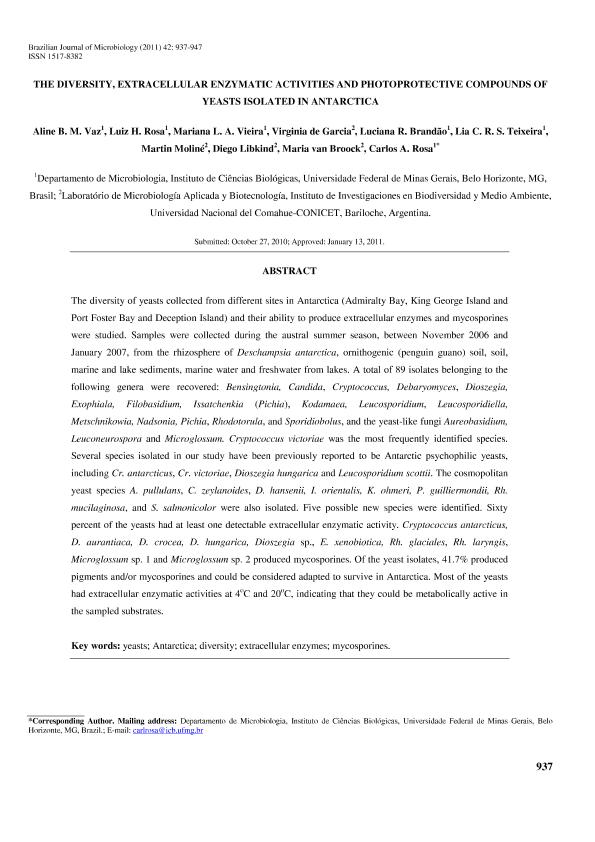Artículo
The diversity, extracellular enzymatic activities and photoprotective compounds of yeasts isolated in Antarctica
Vaz, Aline B. M.; Rosa, Luiz H.; Vieira, Marianan L. A.; de Garcia, Virginia ; Brandão, Luciana R.; Teixeira, Lia C. R. S.; Moline, Martin
; Brandão, Luciana R.; Teixeira, Lia C. R. S.; Moline, Martin ; Libkind Frati, Diego
; Libkind Frati, Diego ; Giraudo, Maria Rosa
; Giraudo, Maria Rosa ; Rosa, Carlos A.
; Rosa, Carlos A.
 ; Brandão, Luciana R.; Teixeira, Lia C. R. S.; Moline, Martin
; Brandão, Luciana R.; Teixeira, Lia C. R. S.; Moline, Martin ; Libkind Frati, Diego
; Libkind Frati, Diego ; Giraudo, Maria Rosa
; Giraudo, Maria Rosa ; Rosa, Carlos A.
; Rosa, Carlos A.
Fecha de publicación:
07/2011
Editorial:
Sociedade Brasileira de Microbiologia
Revista:
Brazilian Journal Of Microbiology
ISSN:
1517-8382
e-ISSN:
1678-4405
Idioma:
Inglés
Tipo de recurso:
Artículo publicado
Clasificación temática:
Resumen
The diversity of yeasts collected from different sites in Antarctica (Admiralty Bay, King George Island and Port Foster Bay and Deception Island) and their ability to produce extracellular enzymes and mycosporines were studied. Samples were collected during the austral summer season, between November 2006 and January 2007, from the rhizosphere of Deschampsia antarctica, ornithogenic (penguin guano) soil, soil, marine and lake sediments, marine water and freshwater from lakes. A total of 89 isolates belonging to the following genera were recovered: Bensingtonia, Candida, Cryptococcus, Debaryomyces, Dioszegia, Exophiala, Filobasidium, Issatchenkia (Pichia), Kodamaea, Leucosporidium, Leucosporidiella, Metschnikowia, Nadsonia, Pichia, Rhodotorula, and Sporidiobolus, and the yeast-like fungi Aureobasidium, Leuconeurospora and Microglossum. Cryptococcus victoriae was the most frequently identified species. Several species isolated in our study have been previously reported to be Antarctic psychophilic yeasts, including Cr. antarcticus, Cr. victoriae, Dioszegia hungarica and Leucosporidium scottii. The cosmopolitan yeast species A. pullulans, C. zeylanoides, D. hansenii, I. orientalis, K. ohmeri, P. guilliermondii, Rh. mucilaginosa, and S. salmonicolor were also isolated. Five possible new species were identified. Sixty percent of the yeasts had at least one detectable extracellular enzymatic activity. Cryptococcus antarcticus, D. aurantiaca, D. crocea, D. hungarica, Dioszegia sp., E. xenobiotica, Rh. glaciales, Rh. laryngis, Microglossum sp. 1 and Microglossum sp. 2 produced mycosporines. Of the yeast isolates, 41.7% produced pigments and/or mycosporines and could be considered adapted to survive in Antarctica. Most of the yeasts had extracellular enzymatic activities at 4 oC and 20 oC, indicating that they could be metabolically active in the sampled substrates.
Palabras clave:
Yeasts
,
Antarctica
,
Diversity
,
Extracellular Enzymes
,
Mycosporines
Archivos asociados
Licencia
Identificadores
Colecciones
Articulos(CCT - PATAGONIA NORTE)
Articulos de CTRO.CIENTIFICO TECNOL.CONICET - PATAGONIA NORTE
Articulos de CTRO.CIENTIFICO TECNOL.CONICET - PATAGONIA NORTE
Articulos(INIBIOMA)
Articulos de INST. DE INVEST.EN BIODIVERSIDAD Y MEDIOAMBIENTE
Articulos de INST. DE INVEST.EN BIODIVERSIDAD Y MEDIOAMBIENTE
Citación
Vaz, Aline B. M.; Rosa, Luiz H.; Vieira, Marianan L. A.; de Garcia, Virginia; Brandão, Luciana R.; et al.; The diversity, extracellular enzymatic activities and photoprotective compounds of yeasts isolated in Antarctica; Sociedade Brasileira de Microbiologia; Brazilian Journal Of Microbiology; 42; 3; 7-2011; 937-947
Compartir
Altmétricas



